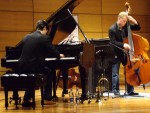Title
For students everywhere, summer means free time, rest, and welcome relief from classes. For Juilliard Jazz students, summer represents the opportunity to be whisked away to some far corner of the world and serve as musical ambassadors of Juilliard. I spent June 19 to July 4—along with trumpeter Randall Haywood, a second-year master’s student; bassist Jason Stewart, a second-year Artist Diploma candidate; and drummer Ryan Hayden (M.M. ’09, jazz studies)—in Colombia, teaching and performing jazz music, and having an amazing time. Thanks to a partnership between Juilliard and Centro Cultural Americano in Colombia, the four of us traveled to three different cities, each with its own unique character and landscape, but with the common thread of welcoming locals and a true interest in jazz music.
Body
Our journey began as most international travel does: early! We checked in at J.F.K. by 9 a.m., and after a layover in Miami we touched down at José María Córdova airport in Medellín, Colombia, at about 7 p.m. local time. The city of Medellín is located in the Aburrá Valley and is surrounded on all sides by mountains. Our first image as we drove down the winding road from the summit was a sprawl of yellow and blue lights stretching across the valley, snugly nestled into the base of the encircling peaks. As we approached the city, we wondered what lay ahead of us in this beautiful and unfamiliar land.
We had our first taste of the local flavor later that night. After checking into Hotel Plaza Rosa we met our guide, Hernando, and took a walk downtown, stopping to dine at a taquería. During our stay in Colombia we ate quite a bit oftípico (traditional local food). We learned that food, like music, is very much segmented by region, and there is a distinctive style to the typical music and food of each locale in Latin America. Tacos are standard fare for most Americans; our more unusual gastronomic experiences included chicharrón, or fried pork rinds; a wide variety of jiggly gelatinous desserts; and a beverage known as aguardiente, which translates as “firewater.” We also sampled local takes on burgers, pizza, and Italian cuisine.
The next day we performed the inaugural concert of the Fête de la Musique festival to a full house at the Alliance Française. The audience was already warmed up from the opening act, a group of local music students who combined traditional melodies and forms with atmospheric synthesizer sounds and epic arrangements. We were later told that the crowd swelled during the intermission, and by the time we played our set the 1,700-seat theater was packed to over capacity. It was an attentive and generous audience, greeting the familiar melody of our opening selection, If I Were a Bell, with warm applause. After the concert we met some of the distinguished guests, including local politicians and a group of students who would soon be traveling to America as part of a special exchange program.
Later in the evening we went downtown to get a proper taste of Medellín nightlife. It was quite different from New York: every door was open, and people came and went freely, lining the streets. Jason, a native of New Orleans, remarked that it reminded him of home.
On Monday we began our residency at two local universities: Universidad Nacional de Colombia sede Medellín, and Universidad EAFIT. The students’ ages ranged from early-teen to adult, and many of them were already professional performers of salsa, classical, and rock music. We discussed the role of each instrument in the ensemble, demonstrated basic and advanced concepts, guided listening sessions, and got them up to play with us and by themselves. They were all highly engaged and asked perceptive questions. Though the residency only lasted a week, many of the students showed significant improvement. We played a concert to close the residency, featuring some of the students on So What, and gave our final performance in Medellín at San Fernando Plaza, a large mall. Many of the students attended, and we were sad to say goodbye to our new friends.
After a quick stop in the city of Cali for a well-attended and well-received concert, we were en route to our final residence as teachers of a weeklong jazz camp in Manizales. Unlike Medellín, which is in a valley next to mountains, Manizales is actually in the mountains and was rather chilly, despite the tropical climate of the country. On the night we arrived, Manizales’s soccer team, Once Caldas, clinched the national championship and we witnessed an extraordinary celebration. Proud sports fans flooded the streets, spontaneous parades formed, and children ran around throwing fistfuls of flour on everybody. Music was in the air with cars honking in clave rhythm, and others joining in to honk cross rhythms.
That week’s classes were similar to those in Medellín, though with only one group we had more time to expand on the concepts we were discussing. We also had a better opportunity to showcase the students in performance, as the concluding concert allowed all of them to show off their progress to their families and friends.
All in all, it was a very productive cultural exchange. We were able to provide the students with perspectives and resources that they don’t have access to every day, and it was rewarding to witness their rapid growth and appetite for knowledge. We connected with the public too; almost every audience demanded an encore, and we felt their love and appreciation for our music and for us traveling there to share it with them. As Randall said at the end of every concert, “We love Colombia. We love the people, the food, the music, and the scenery … and we will be back!” That sentiment, always met with thunderous applause, was clearly mutual.





